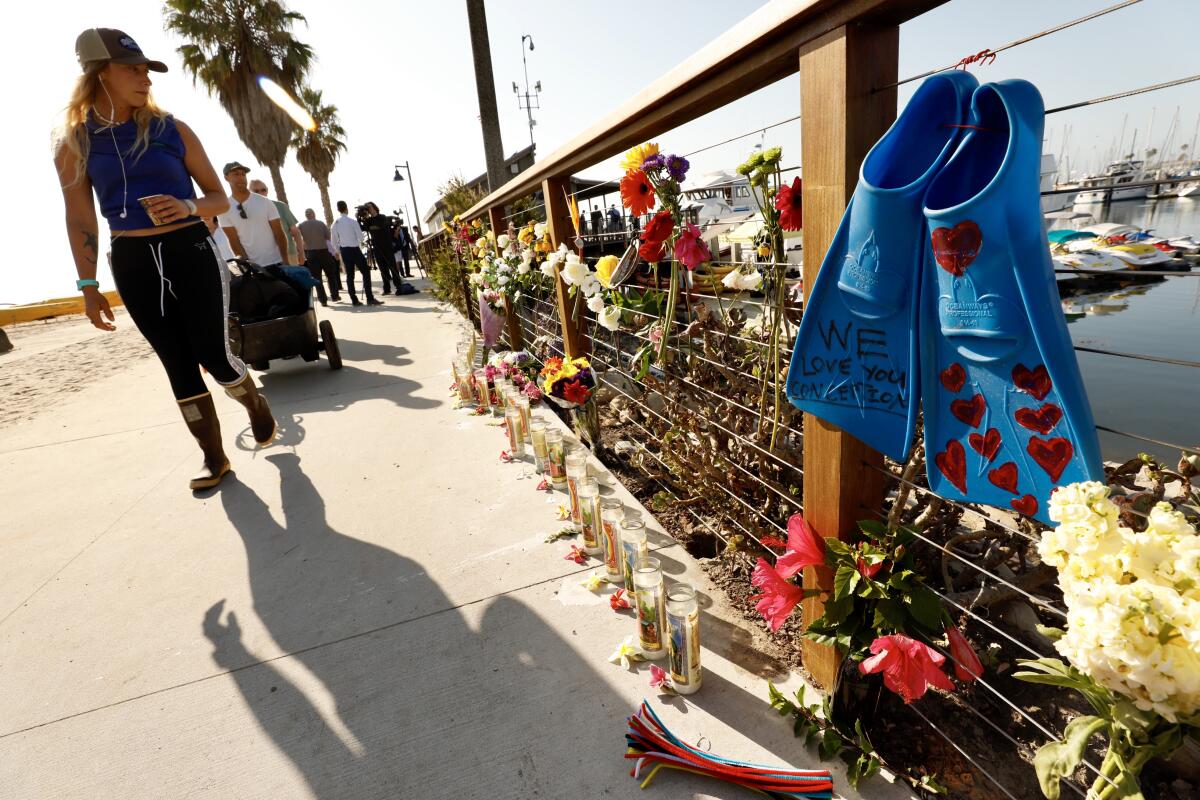Deadly California boat fire devastates community of local divers

- Share via
Over the last 10 years, Ben Wolfe has boarded a boat in the Santa Barbara Harbor with his wet suit and scuba tank, ready to catch lobsters.
His annual trip is usually scheduled for the opening weekend of lobster season — around the end of September — and takes him and 30 other people more than 100 miles south, landing just north of the Mexican border.
Whether the trip will happen this month, however, is unclear. One of the boats typically used — a 75-foot vessel called Conception — was destroyed in a fire Monday while anchored off Santa Cruz Island during a three-day dive excursion.
Five crew members managed to escape the inferno, but officials had little hope of finding anyone else alive. Thirty-nine people were on board when the fire broke out. As of Tuesday morning, the remains of 20 people — 11 female and nine male — had been found. Fourteen others were still missing, officials say.
Kristy Finstad, a 41-year-old marine biologist who organizes Wolfe’s annual trip, is among those presumed dead.
“I don’t know who else I know on that boat,” Wolfe said.
In the coastal communities of Ventura and Santa Barbara, scuba diving in the compact archipelago that is Channel Islands National Park is a culture, an industry and one of the hottest attractions around.
The area around Santa Cruz Island is a diving mecca where underwater explorers can see reefs and seaweed teeming with fish flashing kaleidoscopically vivid colors, octopuses as big as basketballs and bright orange garibaldi, the California state marine fish.
Divers can even look one of the biggest fish of all, the giant sea bass, right in the eye.
But on Tuesday, one of the worst maritime disasters in recent memory had cast a pall over Southern California’s close-knit diving communities and left them in shock, offering condolences and bracing for a downturn in the mostly affluent clientele they rely upon to keep the wheels of commerce turning.
“We’re also in a stand-by mode, waiting for facts about the circumstances surrounding this horrific tragedy,” Tom Ingram, president of the Diving Equipment and Marketing Assn., a trade group, said Tuesday.
“There will soon come a time when our members will need that information, along with some good advice, in order to respond to tough questions from customers about safety and our industry,” he said. “They’ll want reassurances before heading out for a diving tour of up to seven days.”
Among those struggling to come to terms with the disaster was Andrea Miller, 52, a volunteer diver with a Channel Islands National Park educational program that is broadcast live to public classrooms across the United States and Canada.
Miller was among about 30 divers who five weeks ago traveled to nearby Anacapa Island on the Conception.
“I understand that the public is going to have a hard time overcoming a sense of fear and trauma from what was apparently an entirely freak incident,” she said. “My hope is that we’ll find the words to keep diving an active, viable sport.”
Local, state and federal investigators are trying to determine exactly what went wrong on the Conception, a vessel once described by California Diving News as “California’s crown jewel of live-aboard dive boats.”
Miller said safety is the biggest concern for the diving community because when you’re out at sea, you’re a long way from home.
“So our boats are equipped with firefighting equipment, and we train for man overboard, flooding and fire scenarios — and even in the best conditions we stay in touch with radar and radio communications,” Miller said.
“But many people may not be aware of that,” she added, “so for a while they’re going to worry about getting out on a boat.”
Fatalities and injuries were once common in scuba diving, and usually associated with an individual’s unsafe behavior and hazardous conditions under which a mistake in judgment snowballs into panic.
Since 1970, however, scuba diving has claimed about 80 to 100 lives in the United States each year.
Until now, these statistics reassured many of the 3.5 million people in diving in the U.S.
“Would anyone want to go out on a boat for several days right now and scuba-dive or fish?” Werner Kurn, founder of Ocean Enterprises, a network of Southern California dive shops, asked rhetorically. “Probably not until authorities can figure out exactly how all those people died.”
“In the meantime,” he added, “people who had booked a diving tour to a place like Santa Cruz are going to try and delay it for a few weeks.”
Wolfe, a retired Los Angeles County fire captain, takes two lobster diving trips a year. The first one is organized by Finstad and her husband, Dan Chua, and costs $900, he said.
The four-day trips begin at night when the passengers board and the captain begins the 12-hour journey to Cortes Bank, a barely submerged island that is considered the outermost part of the Channel Islands. There, with no land in sight and just a single buoy on the water, the divers swim into the ocean and catch lobsters by hand.
On these trips, Wolfe has gotten to know Finstad, Chua and the ship’s captain, Jerry Boylan, he said. Passengers relax on deck together and share meals. The boat usually has an electric barbecue on deck where a cook makes tri-tip.
The same people tend to go on these trips, so they get to know one another. Many of them are experienced divers, he said.
“It just tells you the people that are on these trips, these are capable people. If they got trapped below deck and couldn’t make it out, that tells you something really bad happened, really quick,” he said.
Two weeks ago, Wolfe, who lives in Santa Barbara, took a multi-day trip on the Conception, to go fishing with some friends — lobster season hasn’t started yet. The journey took them from Santa Barbara Island to Cortes Bank to Santa Cruz Island.
Wolfe said every time he boards a boat from Truth Aquatics, the operator of the Conception, the crew gives a 20-minute safety presentation that covers the location of life jackets and boats and emergency exits.
“They cover it every time they go out, whether you’ve heard it 100 times or not. They’re totally safety-conscious,” he said. “I feel better about going out with them than I do on my own boat.”
More to Read
Sign up for Essential California
The most important California stories and recommendations in your inbox every morning.
You may occasionally receive promotional content from the Los Angeles Times.











